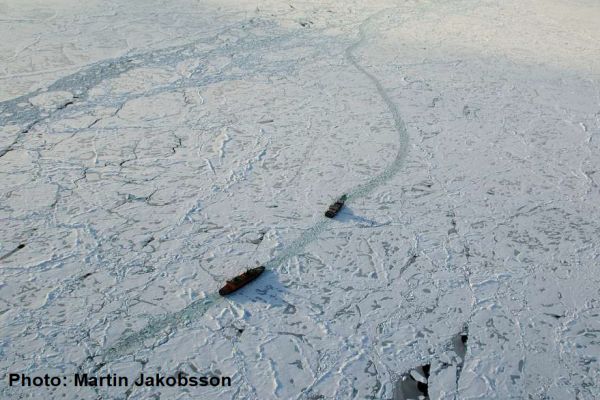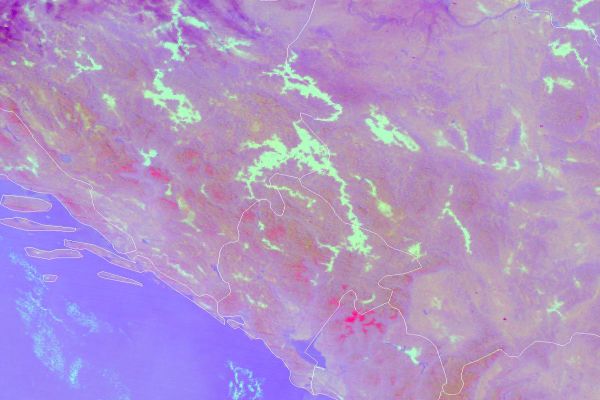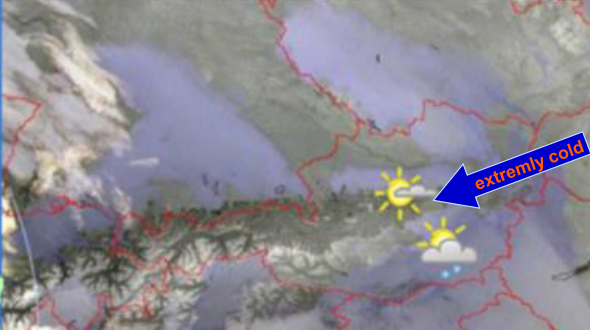Identify surface features
Patrick Eriksson speaks about monitoring sea ice in the very heavily trafficked Baltic Sea
The Baltic Sea, a relatively small semi-closed basin with brackish water, is one of the most heavily trafficked sea areas in the world. Thousands of vessels visit ice-infested ports every winter, which requires well organized icebreaking. To support this winter navigation operation, the Ice Service at FMI conducts monitoring and forecasting of the sea ice throughout the winter. An essential source of information is obviously satellite data. Imagery from several satellite platforms is not only processed to serve ice charting and reporting, but is also delivered in near-real-time straight to the bridges of the icebreakers. The dark and cloudy Nordic winter has proven the Synthetic Aperture Radar instruments (SAR) to be the most suitable when analysing the development of the sea ice. Different passive instruments are also used, light and cloudiness permitting. All satellite platforms bring their various strengths and limitations on the ice analyst’s desktop, causing constantly changing challenges to the charting of sea-ice features. So far, the analysis has been predominantly manual work, but the ever-increasing data volumes are setting a demand for AI-based automatic interpretation.
Vojtěch Bližňák presents how the satellite cloud data helps forecasting road surface temperature in Czechia.
The goal of the contribution is to assess an impact of extrapolated cloud cover derived from satellite observations on forecasts of road surface temperature (RST) performed by the road weather model (RWM) FORTE. Based on road weather station measurements and forecasts of the ALADIN numerical weather prediction (NWP) model, which are used as inputs to prepare initial and boundary conditions, the RWM generates a linearly continuous forecast of RST on selected Czech highways. The work will compare the evaluation of RST forecasts generated by two model runs using NWP and satellite-derived cloud cover estimation.
Vesa Nietosvaara showcases how the MTG's FCI instrument will improve the quality of satellite data, especially for users in high latitudes.
The first Meteosat Third Generation (MTG-I) satellite with Flexible Combined Instrument (FCI) was launched at the end of 2022. It will be followed later in 2024 by MTG-S Satellite with Infrared Sounder onboard. MTG will carry novelty instruments – Infrared Sounder, Lightning Imager and Ultraviolet Visible Near-infrared (UVN) Spectrometer - in the GEO orbit. Meteosat Third Generation aims to secure continuity and to increase the capabilities of the Meteosat satellites in response to requirements of the future forecast/nowcast systems. Altogether, the new and enhanced capabilities will allow us to make a huge step in better monitoring of our environment, and allowing development of new applications.
This case study treats snow detection with the Cloud Phase RGB.
During 07-10 January 2021, a winter storm produced a significant 30-50 cm snow depth over large parts of Spain. We studied this snow cover over the following ten days in VIIRS Cloud Phase RGB images. The Cloud Phase RGB is a composite image, which will also be available with data from the future Meteosat Third Generation (MTG) imager.
Roland Winkler talks about the safety and economic impact of wind in aviation.
Despite ever-advancing technology and automation, weather continues to have a major impact on aviation. Weather forecasts in aviation have two important functions. They support safety on the one hand and economic efficiency on the other. As part of this presentation, I would like to take a closer look at the complex subject area that the wind exerts on the approach and departure.
Irene Schicker taks about wind forecasts needed to efficiently operate wind turbines.
With the increase in wind energy production being fed into the power grid accurate high frequency predictions of the estimate d power for the next hours and days ahead are needed to schedule feed-in rates and secure power grid stability. To achieve this a combination of different kinds of information and data sets are needed. Here, statistical and machine learning methods proved to be a suitable tool. However, a thorough selection of input data is needed as well as considering extreme events (upper and lower tails) in model training and avoiding smoothed forecasts.
A brief introduction into post-processing for wind energy applications using statistics and machine learning, including useful tools/methods/data, will be given.
Sabine Zerobin recaps the steps necessary to plan, construct and operate wind turbines.
A reliable wind measurement is the basis for the successful accomplishment of wind power projects and the profitable operation of wind farms. Therefore, the current presentation gives an overview about the steps that are necessary to develop a wind power project from the green field, starting with a well-defined measurement campaign. Besides constraints originating from the conditions on site, pros and cons of different measurement techniques as well as the corresponding technical standards have to be kept in mind.
Reaching the measurement target therefore means, that sufficient data in a good quality is available to be used for further evaluations andassessments of the regarded site, which are then used to determine whether a project can be realised in terms of profit as we ll as from the technical point of view.
Even after a successful realisation of a project, wind measurements still play an important role, especially when it comes to the verification of the plant performance.
Gernot Zenkl presents the types of meteorological situation that can lead to critical avalanche situations in the eastern Alps.
Length: 45 minutes.
In this presentation one could see a short overview of the interesting and challenging work as an avalanche forecaster. Gernot Zenkl has shown which types of meteorological situation can lead to critical avalanche situations in the eastern Alps. Furthermore he explained the methods we use to inform and warn the people.
Zuhal Akyurek reports on snow reflectance characteristics that have to be considered in snow detection from satellite data.
Snow on the ground differs from most of the Earth surfaces by its high reflectance or albedo in the visible and near-infrared wavelengths (0.350 to 1 μm). For longer, the snow’s reflectance decreases significantly. In these wavelengths,snow is even less reflective than certain types of vegetation. Most of the incident radiation in these wavelengths is absorbed in the snowpack. These unique spectral characteristics are used in optical remote sensing to distinguish between snow and other types of surfaces. The numerous validation studies indicate that the satellite snow products have large snow mapping accuracy with respect to ground snow observations for cloud-free conditions, which varies between 69 and 94% in the winter seasons. The main limitation of existing optical platforms operating at a daily timescale is cloud coverage, which significantly reduces the availability of snow cover information.
In this session, algorithms used to retrieve HSAF snow products; snow mask (H31, H34) and effective snow cover area (H32, H35) from opticalsatellite data are presented. The challenges and the opportunities in retrieving snow cover mapsfrom optical data are discussed.
Ali Nadir Arslan gave an overall introduction of the H SAF products with a focus on snow detection.
The operational goal of H SAF highlights the need to provide products with a reliable measure of their accuracy, so the potential users are made aware of the advantages and drawbacks of the use of the H SAF products in their operational activities. With this aim, within the H SAF, three Validation Groups have been established: one for precipitation, one for soil moisture and one for snow products.
An overview of existing and future satellite-derived snow products will be provided.
Silvia Puca gave an overall introduction of the H SAF products.
In the first part of the session an introduction to the EUMETSAT HSAF project is made. The EUMETSAT Satellite Application Facility on Support to Operational Hydrology and Water Management (H SAF) started in 2005 and aims to provide remote sensing estimates of relevant hydrological parameters: instantaneous rain rate and cumulated rainfall, soil moisture at surface and in the root zone, snow cover and water equivalent. The project involves experts from 12 national meteorological and hydrological European Institutes of Austria, Belgium, Bulgaria, Finland, France, Germany, Hungary, Italy, Poland, Romania, Slovakia and Turkey, and from the European Centre for Medium-range Weather Forecast (ECMWF).
Kenan Bolat reports on H SAF snow detection product H34 that is derived from the SEVIRI instrument on-board MSG H34 differs for flat and mountainous regions.
H34 is a snow mask product, which is retrieved from optical imaging radiometer Spinning Enhanced Visible and Infrared Imager (SEVIRI) mounted aboard the geostationary Meteosat Second Generation (MSG) satellite operated by EUMETSAT. MSG/SEVIRI provides continuous imaging of the earth in 12 spectral channels with a repeat cycle of 15 min. The imaging spatial resolution is 3 km at sub-satellite point and degrades to 5 km over Europe. The snow cover mapping is based on a multi-channel retrieval algorithm. It exploits the high reflectivity of snow in the visible spectrum and the low reflectivity at shorter wavelengths. The snow cover retrieval algorithm differs for flat and mountainous regions. Considering the different characteristics of snow for mountainous and flat areas, two different algorithms are used in producing the snow products for flat and mountainous areas, and then the products are merged to have a single snow product.












